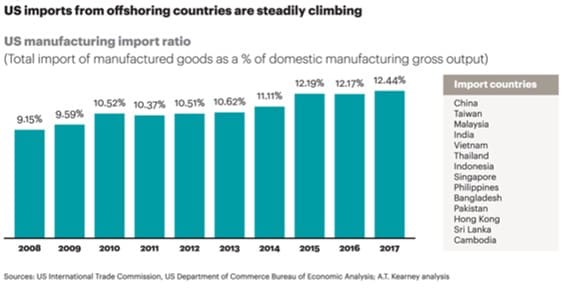A.T. Kearney publishes an annual study on reshoring. Their July 2018 release – their fourth annual “Reshoring Index” – shows record imports from traditional offshoring countries in 2017. “Imports of manufactured goods into the United States from the 14 largest low-cost-country trading partners in Asia rose by a staggering $55 billion, or 8 percent—the largest one-year increase since the economic recovery of 2011… Relative growth of imports from the low-cost country trading partners has now outpaced relative growth of US manufacturing gross output in four of the past five years and eight of the past 10 years, showing a clear direction away from significant reshoring. Since 2013, when A.T. Kearney first started studying reshoring as a phenomenon, imports of manufactured goods from the 14 largest low-cost countries have increased by $118 billion, or 19 percent, while US manufacturing gross output has grown by only $81 billion, or 1 percent.”

The report cites several reasons for this ongoing trend. These include, the continued cost savings from producing labor-intensive products overseas; companies are reluctant to prematurely abandon large offshore investments that have already been made; a shortage in the U.S. of skilled labor for manufacturing; and the fact that the growth in imports is less from additional manufacturing moving offshore to low-cost countries and more from manufacturing operations that are already there but are increasing their volumes. for the time being, ocean freight costs are still manageable, there is a certain “offshoring inertia” that will not reverse this trend overnight.
But they argue, that “tariffs and political posturing could impact and potentially change the direction of the reshoring trend.” If you are looking for manufacturers to grow jobs based on increasing exports out of the US, that will not happen. Abba Lerner from the London School of Economics proved all the way back in 1936 that an import tariff was the equivalent of a tax on exports. What he showed theoretically, has been proven by historic trade flows. And the Lerner Symmetry Theorem does not even factor in tat for tat reprisals like we have seen from China and Europe that led Harley Davidson to open a plant in Thailand. Greg Ip wrote an astute column on this in the Wall Street Journal titled “Exporters are Surprise Losers in Tariff Fight.”
Nonetheless, if the goal is to increase US output (and American jobs and wages), the main driver does not have to be reshoring. American companies may choose to manufacture an increasing portion of their goods in the U.S. to support the domestic market, and foreign companies can decide to open factories in the U.S. to better serve the U.S. market.
Both tariffs and tax law changes were expected to create a wave of reshoring. The tax changes allow US-based multinationals to bring back billions of dollars that they moved offshore if they pay a one-time tax over an eight-year period.
The supply chain design decisions are quite complex. Repatriated funds can make a CEO’s life far easier if the funds are earmarked for stock buy-backs and dividends. So far, that is where much of the tax savings have been allocated. Reshoring also requires substantial capital investments, and if offshoring was driven by labor arbitrage, those costs increase as substantial amounts of automation are needed. Kearney reported in their 2015 Reshoring Index, that “74 percent of companies that reshored chose to minimize their capital outlay by returning to locations that had been mothballed.” Further, ocean shipping costs remain low.
For further validation that reshoring is not resonating with US manufacturers, Amber Road a Global Supply Chain software vendor, is observing continued growth in their business. “We see growth in all areas of our business, especially in the demand for supplier collaboration and free trade agreement solutions” says Ty Bordner, SVP Marketing for Amber Road. The rising demand for solutions that help digitize the global supply chain and allow companies to better collaborate and automate their cross border business is a clear indicator of the continuing trend to source goods from low cost labor markets. “We see companies relocate manufacturing capabilities between low cost labor countries, like moving from China to Vietnam, or maybe from Asia to Mexico, but we are not seeing any reshoring activity”, says Bordner.
In conclusion, the Kearney report points out, “the long-term trend of manufacturing products for the US market in countries such as China and other Asian low-cost countries has not been curbed and, even though 2017 and the roaring first half of 2018 are providing optimism for the US manufacturing sector, it will take more than political headlines to effect any meaningful and lasting change.”

















